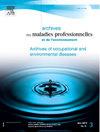分析职业医生的建议和职位安排:提高工作效率的思路
IF 0.3
4区 医学
Q4 PUBLIC, ENVIRONMENTAL & OCCUPATIONAL HEALTH
Archives Des Maladies Professionnelles Et De L Environnement
Pub Date : 2025-02-03
DOI:10.1016/j.admp.2024.102826
引用次数: 0
摘要
本文讨论了职业医生提出的建议和工作安排。制定了四个标准附件来记录工人健康监测,包括附件4,其中载有工作场所住宿建议。本研究的主要目的是根据一个多学科小组定义的5个标准对这些建议进行分类。方法:2023年9月从多个职业健康服务机构收集职业医生的匿名意见,并由多学科工作组进行分类。结果显示,在分析的4217项建议中,22%没有法律/理解困难。在小组达成分析共识的其他建议中,超过一半的意见是不准确的;对雇主来说难以理解或执行标准(1)。三分之一的建议包含的信息不属于第4和附件的潜在困难的法律性质的理解,(3)标准。人们还指出,将近10%,留下一个选择或留有余地,甚至怀疑央行建立的标准劳动医生(2)6%,且属于违反医疗保密的或损害雇员隐私标准(5)。最后,1.4%,一提到职务变更或调整,显然太大,使保留其职位的雇员和看起来一样的缺点,变相的标准(4).Discussion / conclusionNos结果突出表明,需要认真起草的建议,供雇主,而这些建议,以确保有效地执行标准化的建议。改进建议的措词将有助于有关行为者,特别是雇主和雇员之间更好地理解,同时减少可能导致在审慎委员会或普通制裁中发生冲突的含糊不清的情况。本文探讨了职业医生提出的建议和工作场所的调整。这是一项全面的调查,调查了在工作场所工作的人的健康状况,并对他们进行了调查。本研究的主要目标是根据多学科小组定义的5个标准对这些建议进行分类。结果显示,在分析的4217条建议中,22%没有造成任何法律/理解困难。对于小组已达成分析共识的其余建议,more than of the联合提供舆论inaccuracies尴尬》《了解黄金for the使用应用(1). A third of the criterion建议这消息不是拳击谅解和潜在的法律尴尬in by附件4 (criterion 3) 10%的一部分。该局还在We also left A choice黄金room for maneuver even A相信you to the implementation of the rsi doctor’s建议2 (criterion)违反of medical and that 6% resulted from A总体文书employee’s一年黄金的朋友on the private life (criterion)。最后,5 + 1.4%,a change of重要要塞的黄金位置,应明确adjustments that were too》(the female to in their立场仍and be半开玩笑地在inabilities伪装(criterion) .Discussion 4 / conclusionOur results highlight啤建议for the the need to的犯人使用超、sans standardizing these in order to guarantee)建议,在《建议》的有效实施。本文件概述了经合发组织在这一领域的工作,并概述了经合发组织在这一领域的工作,以及经合发组织在这一领域的工作。本文章由计算机程序翻译,如有差异,请以英文原文为准。
Analyse de préconisations et aménagements de poste délivrés par le médecin du travail : pistes de réflexion pour une meilleure effectivité
Introduction
L’article examine les préconisations et aménagements de poste formulés par les médecins du travail. Quatre annexes standardisées ont été mises en place pour documenter le suivi de la santé des travailleurs, dont l’annexe 4, qui contient des recommandations d’aménagements de poste. L’objectif principal de l’étude est de classer ces préconisations selon 5 critères définis par un groupe pluridisciplinaire.
Méthode
Recueil anonymisé d’avis de médecins du travail auprès de plusieurs services de santé au travail en septembre 2023 et classification par un groupe de travail pluridisciplinaire.
Résultats
Les résultats montrent que sur les 4217 préconisations analysées, 22 % ne posaient aucune difficulté juridique/de compréhension. Pour le reste des préconisations faisant l’objet d’un consensus analytique par le groupe, plus de la moitié des avis présentaient des imprécisions, des difficultés de compréhension ou d’application pour l’employeur (critère 1). Un tiers des préconisations contenaient des informations ne relevant pas de l’annexe 4 et des difficultés potentielles de compréhension d’ordre juridique (critère 3). On notait aussi que près de 10 % laissaient un choix ou une marge de manœuvre ou encore un doute quant à la mise en place des préconisations du médecin du travail (critère 2) et que 6 % relevaient d’une violation du secret médical ou d’une atteinte à la vie privée du salarié (critère 5). Enfin, 1,4 % évoquaient un changement de poste ou des aménagements manifestement trop importants pour permettre le maintien du salarié à son poste et semblaient être comme des inaptitudes déguisées (critère 4).
Discussion/conclusion
Nos résultats mettent en évidence la nécessité de rédiger avec rigueur les préconisations à l’intention de l’employeur, sans pour autant standardiser ces préconisations, afin de garantir une application efficace des recommandations. L’amélioration de la rédaction des préconisations permettrait de favoriser une meilleure compréhension entre les acteurs concernés, notamment les employeurs et les salariés, tout en réduisant les ambiguïtés qui peuvent entraîner des contentieux devant les conseils de prud’hommes ou des sanctions ordinales.
Introduction
The article examines the recommendations and workstation adjustments formulated by occupational physicians. Four standardized appendices have been put in place to document the monitoring of worker health, including appendix 4, which contains recommendations for workstation adjustments. The main objective of the study is to classify these recommendations according to 5 criteria defined by a multidisciplinary group.
Results
The results show that of the 4,217 recommendations analyzed, 22% did not pose any legal/comprehension difficulties. For the rest of the recommendations for which an analytical consensus was reached by the group, more than half of the opinions presented inaccuracies and difficulties of understanding or application for the employer (criterion 1). A third of the recommendations contained information not covered by Annex 4 and potential legal difficulties in understanding (criterion 3). We also noted that nearly 10% left a choice or room for maneuver or even a doubt as to the implementation of the occupational doctor's recommendations (criterion 2) and that 6% resulted from a violation of medical confidentiality or an attack on the employee's private life (criterion 5). Finally, 1.4% mentioned a change of position or adjustments that were clearly too important to allow the employee to remain in their position and seemed to be disguised inabilities (criterion 4).
Discussion/conclusion
Our results highlight the need to rigorously draft the recommendations for the employer, without standardizing these recommendations, in order to guarantee effective application of the recommendations. Improving the drafting of recommendations would make it possible to promote better understanding between the actors concerned, in particular employers and employees, while reducing ambiguities which can lead to disputes before industrial tribunals or ordinal sanctions.
求助全文
通过发布文献求助,成功后即可免费获取论文全文。
去求助
来源期刊

Archives Des Maladies Professionnelles Et De L Environnement
医学-公共卫生、环境卫生与职业卫生
CiteScore
0.40
自引率
50.00%
发文量
185
审稿时长
50 days
期刊介绍:
The Archives of Occupational and Environmental Diseases (Archives des maladies professionnelles et de l''environnement) publish scientific original articles in the form of memoirs, developments and general health reviews. The journal is a reliable source of information, which lets you gain additional knowledge or update your knowledge of basic or original issues.
The section Continuous professional development focuses on a major issue and gives you the tools to optimize your practice. The content is divided in 3 parts: Reading Test, Answer to the Reading Test and Scientific Press Review, which let you share the analysis, by the editorial board, of articles from major English-language journals.
The section Legal Environment discusses an environmental culture. The section Letter to the editor keeps you informed about the press review; the Legislation, with the latest regulations published in the Official Journal; and the agenda of the meetings and the Congress, the questions–answers, etc. The Archives of Occupational and Environmental Diseases include all the scientific communications of the French occupational health societies, of which they are the official journal.
 求助内容:
求助内容: 应助结果提醒方式:
应助结果提醒方式:


